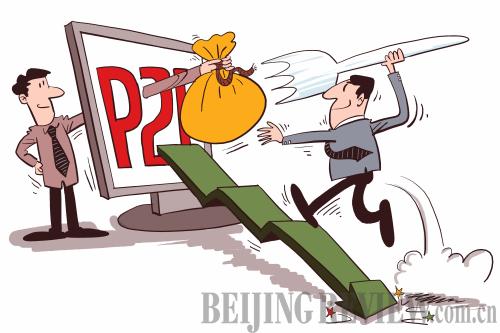|
 |
|
(CFP) |
In China, there are many cash-hungry small and micro businesses whose needs for financial services are often ignored by big banks. On the flip side, the country, whose people have a tradition of saving, is also full of savvy investors who are in dire need of an outlet for their spare cash.
The peer-to-peer lending industry, also known as P2P, seizes this business opportunity by absorbing idle money from individuals and then providing funds to creditors that are desperate for cash. Hence, it has become a thriving and quite lucrative sector in recent years.
P2P lending is the practice of lending money to unrelated individuals and small businesses without going through a bank. This lending takes place on P2P websites. It has an average yearly interest rate of 15 to 20 percent, four to six times the returns on bank deposits in China.
In most cases, such loans are of an unsecured personal nature, and borrowers do not provide collateral against default. But now, in order to lure investors, some P2P websites in China have begun to offer principal and interest guarantees to investors, using profits accrued from the websites or services of cooperative guarantee companies.
By matching creditworthy borrowers and canny investors, the P2P lending industry is flourishing in China. However, frequent occurrence of P2P website bankruptcy or disappearance has alerted investors to the enormous fraud or default risks accompanying the promised high returns and highlighted the need for tougher regulation.
P2P lending was introduced to China in 2006. Due to a poor-performing stock market since 2008 and low bank deposit rates, Chinese investors were quick to turn to P2P sites in the quest for higher investment returns.
P2P operations became red-hot in China's Internet finance sector in 2013, with the number of new companies surging and transaction values skyrocketing.
By the end of 2013, the number of P2P lending companies in China had exceeded 800 with a yearly turnover of 100 billion yuan ($16 billion), according to Wangdaizhijia (literally, "home of online lending"), a Web portal that tracks the industry.
The China Financial Stability Report, released by the People's Bank of China, the central bank, has made a more conservative estimation, saying there were more than 350 active P2P online lending platforms at the end of last year, with an accumulative turnover of 60 billion yuan ($9.6 billion).
Risky elements
As tempting as its high-return promise sounds, the P2P lending industry is plagued by many risks, including excessive exposure to high-risk industries, poor investment portfolio management, misleading and deceptive promotion, illegal lending and the absence of a sound credit-rating system. Investors find it difficult to tell which platform is rule-abiding and promises of guaranteed repayment are often a sham.
In April, a P2P lending platform named Wangwangdai simply disappeared with a huge amount of money raised from individual investors.
Wangwangdai is not an isolated case. There are dozens of P2P lending platforms allegedly involved in illegal activities, which are being investigated.
| 